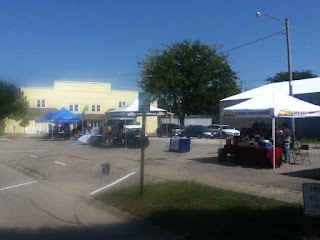 |
So how do we get people out of their cars and on their feet (or bicycles)? Speck and his co-authors had already described the prerequisites for most people: meaningful destinations, safe streets, comfortable streets, and interesting neighborhoods (Duany, Plater-Zyberk, and Speck 2010: 64-83).
The meaningful walk
Most people do not walk for the fun of it: "The first rule is that pedestrian life cannot exist in the absence of worthwhile destinations that are easily accessible on foot" (Duany et al. 2010: 64). The Mound View neighborhood northeast of Coe's campus has a grocery store, two parks, and several pubs all within an easy distance from most people's homes. When we lived in Mound View, we made regular summer strolls to this Dairy Queen:
Downtown Cedar Rapids is evolving into a walkable place, albeit with less in the way of life's necessities like groceries. (The pub pictured has closed, but there are plenty to take its place.)
The proximity of this grocery store to the Wellington Heights neighborhood means that a lot of people walk to it, in spite of the perilous crossing at 1st Avenue:
Walkable areas mix residential and commercial uses--take that, Euclidean zoning!--and are best based on a critical mass of locally-owned businesses. For some starter tips, check out the work of Stacy Mitchell at the Institute for Local Self-Reliance.
The safe walk
Most people will not walk where they do not feel safe. People feel safe from cars when streets are narrow and/or there is a buffer between cars and pedestrians. People feel safe from cars when buildings are designed to facilitate "eyes on the street" (a phrase made famous by Jane Jacobs) i.e. windows not walls. In downtown Fairfield, people crossing the main street from the park to the shops have a short hop where they and the crossing area are both clearly visible.
 |
| Photo courtesy of Ben Kaplan |
Streets through Cedar Rapids's Wellington Heights neighborhood were widened and made one-way in the 1960s to facilitate the speedy movement of cars. Thankfully, the streets were redesigned in 2019--though still wide--slowing the cars, and making the neighborhood more walkable and neighborly.
The very suburban area around Westdale doesn't feel safe to walk. Cars are fast and loud, and there are many places where they turn onto and off of the main drags. Streets are difficult and dangerous to cross.
Edgewood Road, pictured above, is a classic stroad. Pete Saunders is hopeful stroad design can be repaired, improving housing supply as well as walkability: This kind of suburban infill could relieve pressure on hot urban neighborhoods, thus reducing the displacement of poorer families. If developers include affordable housing in the mix, it could bring more people closer to the jobs in suburban office parks that are currently out of reach for many city residents. Maybe, but it's expensive, unlike toning up a core neighborhood where the grid pattern already exists.
Jeff Speck has specific design recommendations for safe walking (2012, ch. 5). Slip lanes are not safe... period!
The comfortable walk
Flat, simple, continuous front walls, narrow streets, and rows of street trees create a "degree of architectural enclosure--the amount that it makes its inhabitants feel held within a space.... Whatever the cause, people are attracted to places with well-defined edges and limited openings, while they tend to flee places that lack clear definition or boundaries" (Duany et al. 2010: 74-75). The comfortable feeling of 8th Street SE, even though this section is largely comprised of parking lots, comes almost entirely from the strategically-placed trees.
Waterloo artist Michael Broshar brilliantly captures how the design of this Chicago street feels both comfortable and interesting:
The same feeling comes from Gustave Caillebotte's beloved "Paris Street-Rainy Day," even though Caillebotte intended it to depict alienation.
This intersection on the north end of campus does not feel comfortable or safe, which has hampered development in that neighborhood.
The interesting walk
"For people to walk," write Duany and colleagues, "a neighborhood has to be interesting: not terribly so, but enough to convey some notion of human activity" (2010: 80). I love discovering little side-yard gardens, like this one in Oak Hill-Jackson:
16th Avenue SW, the historic commercial street of Czech Village, features shops built to the sidewalk, generous windows, and occasional benches:
The most effective way to keeping the planet habitable is to get people out of cars and onto streets. For most people, that requires re-thinking how we design streets, neighborhoods, and towns.
SEE ALSO:
Andres Duany, Elizabeth Plater-Zyberk, and Jeff Speck, Suburban Nation: The Rise of Sprawl and the Decline of the American Dream (North Point, 10th anniversary ed., 2010)
Diana Ionescu, "Cleveland Mayor Wants a 15-Minute City," Planetizen, 18 April 2022
Charles Marohn, "To Fully Observe, We Need to Walk," Strong Towns, 25 April 2022
Jeff Speck, Walkable City: How Downtown Can Save America, One Step at a Time (North Point, 2012)





.png)















